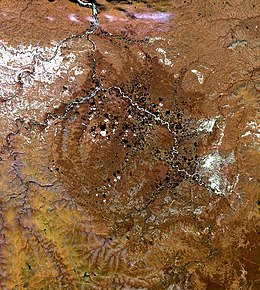Popigai impact structure
| Popigai impact structure | |
|---|---|
 Landsat image of Popigai crater | |
| Impact crater/structure | |
| Confidence | Confirmed |
| Diameter | 90 km (56 mi) |
| Age | 35.7 ± 0.2 Ma Late Eocene |
| Exposed | Yes |
| Drilled | Yes |
| Bolide type | H chondrite |
| Location | |
| Coordinates | 71°39′N 111°11′E / 71.650°N 111.183°E |
| Country | Russia |
| State | Krasnoyarsk |

The Popigai impact structure is the eroded remnant of an
fourth largest verified impact structure on Earth.[1][2] A large bolide impact created the 100-kilometre (62 mi) diameter crater approximately 35 million years ago during the late Eocene epoch (Priabonian stage).[3][4] It might be linked to the Eocene–Oligocene extinction event.[5]
The structure is 300 km (190 mi) east from the outpost of
Khatanga and 880 km (550 mi) northeast of the city of Norilsk, NNE of the Anabar Plateau. It is designated by UNESCO as a Geopark, a site of special geological heritage.[6] There is a small possibility that the Popigai impact crater may have formed simultaneously with the approximately 35-million-year-old Chesapeake Bay and Toms Canyon impact craters.[3]
For decades, the Popigai impact structure has fascinated
geologists, but the entire area was completely off limits because of the diamonds found there. However, a major investigatory expedition was undertaken in 1997, which greatly advanced understanding of the structure.[6] The impactor is suggested to have been a H chondrite asteroid based on ejecta layers from Italy, with the impactor thought to have been several kilometeres in diameter.[7]
The shock pressures from the impact instantaneously transformed graphite in the ground into diamonds within a 13.6 km (8.5 mi) radius of the impact point. These diamonds are usually 0.5 to 2 mm (0.020 to 0.079 in) in diameter, though a few exceptional specimens are 10 mm (0.39 in) in size. The diamonds inherited the tabular shape of the original graphite grains and also the original crystals' delicate striations.[6]
Diamond deposits

Most modern industrial diamonds are produced
gems.[12]
Additionally, carbon
polymorphs, a combination of diamond and lonsdaleite even harder than pure lonsdaleite, have been discovered in the crater.[13][14]
See also
- List of impact craters on Earth
- List of possible impact structures on Earth
- Logancha crater
References
- ^ "Popigai". Earth Impact Database. Planetary and Space Science Centre University of New Brunswick Fredericton. Retrieved 2017-10-09.
- ISBN 978-3-540-43517-4.
- ^ .
- ISBN 978-3-540-43517-4.
- ^ "Russia's Popigai Meteor Crash Linked to Mass Extinction". Live Science. June 13, 2014.
- ^ .
- .
- PMID 26424384.
- ^ a b "Diamonds Beneath the Popigai Crater -- Northern Russia". geology.com. 23 September 2012. Retrieved 24 September 2012.
- ^ a b "Russia declassifies deposit of impact diamonds". ITAR-TASS. 17 September 2012. Archived from the original on 20 September 2012. Retrieved 17 September 2012.
- PMID 19257519.
- Lisa Zyga (12 February 2009). "Scientists Discover Material Harder Than Diamond". Phys.org.
- ^ Pros and cons of extraterrestrial diamonds Archived 2014-12-22 at the Wayback Machine, from "Rough&Polished–information and analytics on diamond and jewellery markets."
- .
- S2CID 73443676.



